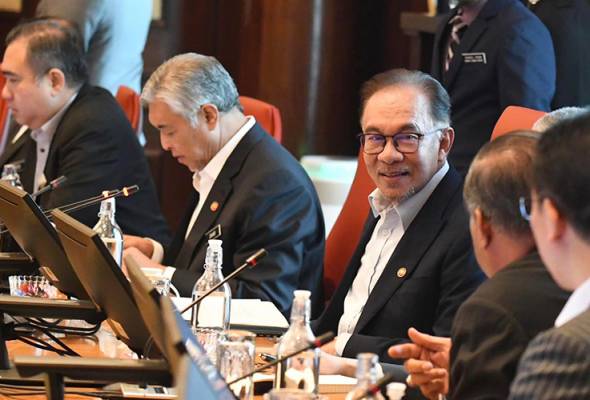
Published in AsiaNewsToday & Astro Awani, image by Astro Awani.
In EMIR Research article, “Immediate priorities of the PM” (December 1, 2022), we called on the government (in coordination with Bank Negara considered as part of the “general government sector” and, hence, under the Executive without in anyway compromising its independence and autonomy) to implement a dual-interest rate regime.
A dual-interest rate regime could be considered as one form of coordination between fiscal (government) and monetary (central bank) policy – where the latter provides support for the former rather than both being “disjunctive” or “discrete” as typically the case or where the former is beholden to the latter, instead.
It’s already, in effect, been implemented by the European Central Bank (ECB) of the EU under its targeted longer-term refinancing operations (TLTROs) since 2014 as the most prominent example.
The central difference between this and EMIR Research’s proposal is that the former applies to the origination (i.e., new) loans and the latter is meant for pre-existing loans (i.e., reversion to the older interest rate setting).
The other examples would be like:
- The Bank of Japan (BOJ)’s targeted lending facilities – where under the fund provisioning measures, interest rates have been between -0.1% and 0% to 0.1%; as well as
- The Bank of England (BOE)’s Term Funding Scheme (TFS) – introduced in 2016 and closed to new lending in 2018 – which aimed at participating banks and building societies to enable them to borrow funds at a rate close to the bank rate (i.e., near zero) for up to four years.
Under the TLTROs, the ECB has charged negative interest rates, e.g., as low as 0.75%, subject to a non-negative lending performance, between April 1, 2020 and March 31, 2021 with the deposit facility rate (DFR) at -0.5% (see “Targeted monetary policy, dual rates and bank risk taking”, ECB, July 2022).
The maturities of TLROs are longer than one year – which minimises the risk of mismatch of term structural maturities. This is where long-term assets (e.g., loans) aren’t in a position to fund short-term liabilities (e.g., deposits) due to the return exposed to the shock of sudden aggressive hikes in the interest rate (as in the case of the Savings & Loan Crisis of the 1980s in the US).
TLROs simply means that “[t]he ECB funds banks at one interest rate (contingent on net new lending conditions being met) which is independent of the interest on reserves (IOR) rate. Banks [could then] borrow under this scheme at interest rates as low as -100 basis points. Simultaneously, the interest rate on reserves (or deposits held by commercial banks at the ECB) is determined independently under the ECB’s tiered reserve system” (“Dual interest rates give central banks limitless fire power”, Centre for Economic Policy Research/CEPR, September 3, 2020).
Targeted lending (as a correlate or aspect of a dual-interest rate regime), of course, is also another form of targeted subsidy. This is one where the central bank incentivises lending by banks by targeted subsidy via a negative interest rate as in the case of the ECB and BOJ.
Negative interest rate policy (NIRP) (as another correlate or aspect of a dual-interest rate regime), however, has produced mixed results (see e.g., “Lessons from the Swedish Experience with Negative Central Bank Rates”, Cato Journal, Fall 2020). The Riksbank (central bank of Sweden) abandoned the experiment in 2019.
It’s meant to motivate lending by penalising deposits and receiving less in the amount payable (based on the interest rate as set to negative) or otherwise even receiving “free money” in addition to the loan/capital itself. This applies to commercial banks in relation to the central bank (re the corridor rates, i.e., ceiling/overnight lending and floor/deposit) and consumers in relation to the commercial banks.
In pursuing a dual-interest rate regime and, by extension, targeted lending, there’s no need to go negative interest rate.
What needs to be done as a matter of further elaboration is as follows:
1. Addressing concerns of the net interest margin (NIM) re deposits
In addition to the policy proposals outlined in the previous EMIR Research article, Bank Negara could also issue special debt instruments (e.g., a “Bank Negara Monetary Note”/”BNMN 2.0”) under the dual interest regime – which pay a higher rate than the MGS coupon issued by the Ministry of Finance (MOF) which is benchmarked by the Overnight Policy Rate (OPR) – targeted at the commercial banks (as lending institutions).
This would also be one of the first steps towards closer monetary-fiscal policy coordination – because it’d be a type of an asset swap programme (i.e., special kind of qualitative easing/QLE) whereby Bank Negara will exchange higher yielding (“BNMN 2.0”) for lower yielding MGS bonds from the commercial banks.
The term maturity structure of BNMN 2.0 (independent of the OPR and MGS coupon rate) will be long-term and interest income from there will fund the short-term liabilities of the deposits and alleviate any compression in the NIM arising from a dual-interest rate regime. The BNMN 2.0 shall be part of the Institutional Securities Custodian Programme (ISCAP) and tradeable on the secondary markets but limited only to the Kuala Lumpur Interbank Offered Rate (Klibor) banks.
Part of the proposed windfall tax on banks can be paid to Bank Negara to cover costs of the BNMN issuance. Interest earned with Bank Negara could then be earmarked into a special fund for a dual interest rate regime in the future.
A dual interest rate regime also allows for a more targeted coverage between deposits and loan rates. That is, the T20 borrowers would be “subsidising” the interest earned by depositors from the same category – which makes for a fairer and targeted banking “subsidy” system.
2. Addressing concerns over sufficient loan to deposit (LDR) ratio
When it comes to the issue of LDR ratio which is at 85.9% (“Loan demand to buoy Malaysia banking sector”, The Star, December 2 2022) – whereby banks are required by law (under Basel III) to ensure liquidity provisioning, “most banks are already registering high loan and deposit ratios” (Retail loan growth likely to remain strong” (The Star, December 5, 2022).
At the same time, Bank Negara’s latest statistics show that for September 2022, Casa (current account, savings account) deposit growth eased to just 3.7% year on year compared with 6.1% in August, while the Casa-to-total-deposits ratio had fallen to 30.6% from 31.4% (“Banks seen making higher pre-emptive provisions in 3Q”, The Edge Markets, November 29, 2022) – indicating that loans were “outstripping” deposits despite the hikes in OPR due to the need to hold on to more liquid assets under the current condition.
And, hence, by extension, the intense competition for deposits.
To address the situation, Bank Negara could allow for:
a) loan repayments to count as deposits;
b) the setting up of a special purpose vehicle (SPV) to purchase non-performing loans (NPLs) and potential NPLs as measured according to the risk levels and at the same time allow banks to off-load and write-off.
To protect bank’s earnings and minimise the one-off Day One modification loss, which is an accounting standard procedure meaning loss relating to the “opportunity cost over time from not having received the additional cashflow”, it’s proposed that tax holidays and exemptions be given.
A rise in NPLs will affect banks’ earning which in turn might affect the bank’s leverage ratio, i.e., earnings and profitability alongside the liquidity coverage ratio (LCR), i.e., capacity to meet liabilities and obligation and, by extension, capacity to generate new loans (see, “The impact of the liquidity coverage ratio on money creation: A stock-flow based dynamic approach”, Boyao Li, Wanting Xiong, Liujun Chen, & Yougui Wang, Economic Modelling, 67 (2017), pp. 193-202).
Or a consortium could be formed together with Cagamas to offer between zero and 0.5% interest rates to the house owners for the refinancing.
This could be stand-alone or packaged together with the implementation of its shared equity scheme – which has been in the works since the second quarter of 2019 (under the previous Pakatan Harapan government). The scheme could be implemented by increasing Cagamas’ share of co-funding. This means the existing loan is converted into the scheme;
c) To allow the conversion of the shares (of the commercial banks) on a voluntary basis (including the public shareholding spread, i.e., minority shareholders who are members of the public) into deposits. At least, to function as a “secondary” (i.e., reserve) deposit.
3. Reforming the Monetary Policy Committee (MPC)
Ensuring a dual-interest rate regime would also, perhaps, necessitates reforms to the MPC in terms of its mandate and composition (the relevant provisions are Sections 21, 23 and 25). This is to ensure that membership of the MPC is expanded to be more diverse and wide-ranging and representative or inclusive of the broader society.
The MPC should include representations from the Malaysian Trade Union Congress (MTUC), Federation of Malaysian Consumers Associations (Fomca), academicians, chambers of commerce (e.g., Associated Chinese Chambers of Commerce and Industry of Malaysia/ACCCIM), SME associations, Bumiputera business organisations (e.g., Bumiputera Retailers Organisation/BRO), civil society groups (e.g., the Malay Economic Action Council/MTEM), etc.
As an unelected entity, having a more broad-based composition will also enhance accountability and transparency in the decision-making processes.
The mandate of the MPC should be towards achieving “interest rate stability” – whereby the OPR hikes should only be considered under limited or constraint conditions or circumstances. For example, OPR hikes should only be considered when the unemployment rate is below 3.3%. Correspondingly, the incremental or gradual hikes should be in tandem with the gradual reduction thereof.
We should also consider whether the unemployment level is not consistent with the level of GDP growth (which also indicates an over-reliance on foreign labour).
Following from this, another determinant is the second-round propagating effects potentially resulting from and in a wage-price spiral.
In the final analysis, a dual-interest rate regime should allow for a win-win situation for both borrowers and depositors as well as banks.
The national unity government under Prime Minister YAB Dato’ Seri Anwar Ibrahim has shown mettle and determination in tackling the cost-of-living challenges ahead. This includes taking on vested interests.
Moving forward, the immediate priorities of the Prime Minister could well prove to be that key to cementing the national unity government together so that it’ll last the full term.
Dr Rais Hussin & Jason Loh Seong Wei are part of the research team of EMIR Research, an independent think tank focused on strategic policy recommendations based on rigorous research.

